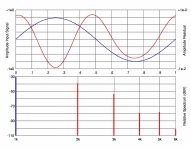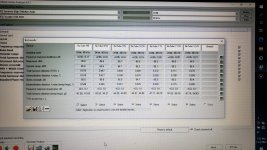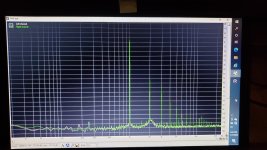I just completed the full kit earlier this evening. I've been playing with bias everywhere from 9.5V to 13V. I think I prefer 13V. Is 13V safe and stable and conducive to longevity? How high can you bias this preamp safely?
I have no idea. Some run it at 12VDC.I just completed the full kit earlier this evening. I've been playing with bias everywhere from 9.5V to 13V. I think I prefer 13V. Is 13V safe and stable and conducive to longevity? How high can you bias this preamp safely?
I measured distortion from 9 volt to 12 volt in half volt increments. Distortion is decreasing with increasing voltage.
I can measure spectra for harmonics, but i am not setup to measure weather 2nd is positive or negative.
Not enough listening test to decide what voltage is best, since it depends a lot what amp follows.
When i used AN39, low distortion classA amp, any settings sounded great.
When i used SE kt88 amp in triode mode, it was too sweet too mushy. But in ultralinear it sounded great.
It all depends. I wish i have answer to your question, but i do not. You have to experiment and decide what sounds best to you.
Cheers!
ps: keep on putting shades on mona lisa like bimo
How much bias you applied to your electric piano Jon?The Korg B1 is an electric piano!
Korg B1 - Google Search
Here is what NP says in his article about high plate voltage, doesn't sound like he is concerned at all about the pot adjust for high plate voltage:I just completed the full kit earlier this evening. I've been playing with bias everywhere from 9.5V to 13V. I think I prefer 13V. Is 13V safe and stable and conducive to longevity? How high can you bias this preamp safely?
"If you have a distortion analyzer which gives you the percentage but not the phase, then just start out with the Plate voltage high (CCW pot) and turn it clockwise to the point where it is minimum, and then go further for + phase, or back up for - phase."
Do you have your speaker cables swapped + & -? Just curious, I like hearing how everyone adjusts the B1 Korg differently.
Hi Greg,
Been there, doing that since 2y. Search function in the main thread is your friend.
Short story:
For more details please refer to the B1K thread
I hope it helps
Claude
Been there, doing that since 2y. Search function in the main thread is your friend.
Short story:
- It is safe, Papa connfirmed it
- you can run higher but will experience then more and more distorsions, but basicaly the B1K is robust
- By running 13V, you are ikely to be on the other side. Say if your null is at 11,V, you are experiencing the same harmonic profile at 13V as at 9V...
- By running 13V, you don't ned to invert the LS speaker cables!
- ... But you still won't get the absolute phase, for that you would need for example to run at 13V + not interverting LS cables + invert phase at the source (some DAC offer that, of course nothing to do with inverting dangerously + and ground at source output!)
For more details please refer to the B1K thread
I hope it helps
Claude
Just to complete my previous post and share MY exprience (your H2 null point may be different!)
I tried various biases over 14V, electricaly no problem, but too much H2 for ME in my system, of course your mileage and taste may vary
Claude
- My null point was somewhere between 11,5V and 12V in MY case, probably closer to 12V
- I like not too much sugar in my set up, so 9.8V... and 13,9V were my prefered settings. They sound quite identical to my rears in terms of overall H2 and H3 distorsions (except for the positive and negative harmonic bit of course). So these settings have in my case the same absolute value harmonic profile, except of course 9.8V gives at the B1K output positive second harmonics (hence inverting the LS cables to get negative ones) while 13,9V produces negative ones at the B1K output (remember B1K inverts phase!)... hence no need to invert LS cables for negative H2.
- Hence me, not wanting to invert LS cables for various reasons, running at 13,9V and not interverting cables. I have negative H2, the H profile I want... BUT I lose absolute phase doing so. That could be restaured by inverting phase at the source, for example, and I would have it all then.
I tried various biases over 14V, electricaly no problem, but too much H2 for ME in my system, of course your mileage and taste may vary
Claude
With 9.5V @ 1Vout (first photo) the second harmonic is 37 dB below the fundamental (1.41%) and 24 dB above the third. If you look at the two positive peaks of the red residue, you see that they are aligned with the positive and negative peaks of the blue fundamental. This indicates that the residue is mainly due to the second harmonic and that the latter has a positive phase. The graph then shows a 2H +. At 12.6V @ 1Vout (second photo) are now the two negative peaks of the red residue which align with the positive and negative peaks of the blue fundamental. The residual indicates a second negative harmonic. Hence 2-. Note that with the last operating point the distribution of harmonics is a little different. If we continue to move it along the load line, with always greater Va, the spectrum worsens rapidly. A sign that 12.6 V is close to triode saturation. Perhaps it is for this reason that Pass indicates 9.5 V as the reference setting of the project and to reverse also the polarity of the speaker to test the negative phase. In this way the positive polarity at the preamp output becomes negative on the speakers.
Attachments
- Home
- Amplifiers
- Pass Labs
- Korg B1 Biasing Question



